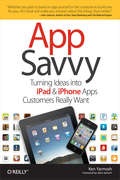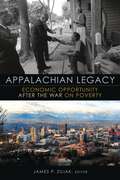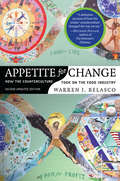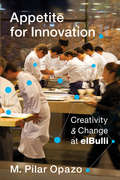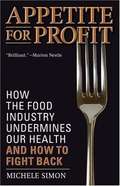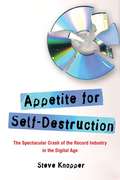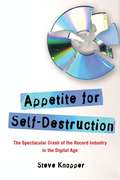- Table View
- List View
Apotheke der Zukunft: Innovation – Digitalisierung – Hybride Versorgung (FOM-Edition)
by David MatusiewiczDie Apotheke als Umschlagsplatz für Arzneimittel hat ausgedient. Internetapotheken, zunehmend digitalisierte Prozesse in der allgemeinen Gesundheitsversorgung (Stichwort E-Rezept), künftig vielleicht sogar personalisierte Medikamente aus dem 3D-Drucker, sind Entwicklungen, auf die das stationäre Apothekengeschäft reagieren muss, um wettbewerbsfähig bleiben zu können.Dieses Buch erläutert die unterschiedlichen Faktoren des Strukturwandels auf dem Apothekenmarkt, lotet die Chancen der Digitalisierung aus, stellt neue mögliche Apothekenmodelle vor, zeigt ausgewählte Start-up-Beispiele, gibt noch länger aktiven Apothekern und Apothekerinnen Tipps für eine Anpassung/Transformation an die zukünftigen Entwicklungen. Es werden ausbaufähige Chancen an den Schnittstellen Apotheke und ambulante Versorgung bzw. Apotheke und nachstationäre Versorgung skizziert, die Platz für neue zukunftsfähige Geschäftmodelle lassen.
App Savvy: Turning Ideas into iPad and iPhone Apps Customers Really Want (O'reilly Ser.)
by Ken YarmoshHow can you make your iPad or iPhone app stand out in the highly competitive App Store? While many books simply explore the technical aspects of iPad and iPhone app design and development, App Savvy also focuses on the business, product, and marketing elements critical to pursuing, completing, and selling your app -- the ingredients for turning a great idea into a genuinely successful product.Whether you're a designer, developer, entrepreneur, or just someone with a unique idea, App Savvy explains every step in the process, with guidelines for planning a solid concept, engaging customers early and often, developing your app, and launching it with a bang. Author Ken Yarmosh details a proven process for developing successful apps, and presents numerous interviews with the App Store's most prominent publishers.Learn about the App Store and how Apple's mobile devices functionFollow guidelines for vetting and researching app ideasValidate your ideas with customers -- and create an app they’ll be passionate aboutAssemble your development team, understand costs, and establish a workable processBuild your marketing plan while you develop your applicationTest your working app extensively before submitting it to the App StoreAssess your app's performance and keep potential buyers engaged and enthusiastic
App-Entwicklung - effizient und erfolgreich: Eine kompakte Darstellung von Konzepten, Methoden und Werkzeugen
by Christian Aichele Marius SchönbergerDieses Buch ermöglicht durch die Darstellung fachlicher und technologischer Grundlagen sowie der Beschreibung notwendiger Aktivitäten zur mobilen Anwendungsentwicklung einen Einstieg in die Thematik. Anhand eines standardisierten Vorgehensmodells werden die einzelnen Phasen der mobilen Anwendungsentwicklung aufgezeigt und die Unterstützung der phasenbezogenen Aktivitäten durch den Einsatz etablierter Entwicklungswerkzeuge dargestellt. Das Buch wendet sich vornehmlich an Unternehmer, IT-Verantwortliche und IT-Praktiker aus IT-anwendenden Unternehmen und IT-Unternehmen. Ferner an Lehrende und Studenten der Wirtschaftsinformatik und BWL.
AppHarvest: Rebuilding the Appalachian Economy Through Agriculture
by William R. Kerr Joshua Lev Krieger Christian GodwinIn 2021, AppHarvest completed construction of a 60-acre indoor farming facility, one of the world's largest, recorded its first sales, and went public in a multi-billion dollar IPO. Described as "a force of nature," Jonathan Webb founded the company to bring jobs back to Appalachia. Now, as he plans for more indoor farms, he has to face the challenges of growing a company quickly.
Appalachian Legacy
by James P. ZiliakIn 1964 President Lyndon Johnson traveled to Kentucky's Martin County to declare war on poverty. The following year he signed the Appalachian Regional Development Act, creating a state-federal partnership to improve the region's economic prospects through better job opportunities, improved human capital, and enhanced transportation. As the focal point of domestic antipoverty efforts, Appalachia took on special symbolic as well as economic importance. Nearly half a century later, what are the results? Appalachian Legacy provides the answers.Led by James P. Ziliak, prominent economists and demographers map out the region's current status. They explore important questions, including how has Appalachia fared since the signing of ARDA in 1965? How does it now compare to the nation as a whole in key categories such as education, employment, and health? Was ARDA an effective place-based policy for ameliorating hardship in a troubled region, or is Appalachia still mired in a poverty trap? And what lessons can we draw from the Appalachian experience?In addition to providing the reports of important research to help analysts, policymakers, scholars, and regional experts discern what works in fighting poverty, Appalachian Legacy is an important contribution to the economic history of the eastern United States.
Appalachian Legacy
by James P. ZiliakIn 1964 President Lyndon Johnson traveled to Kentucky's Martin County to declare war on poverty. The following year he signed the Appalachian Regional Development Act, creating a state-federal partnership to improve the region's economic prospects through better job opportunities, improved human capital, and enhanced transportation. As the focal point of domestic antipoverty efforts, Appalachia took on special symbolic as well as economic importance. Nearly half a century later, what are the results? Appalachian Legacy provides the answers.Led by James P. Ziliak, prominent economists and demographers map out the region's current status. They explore important questions, including how has Appalachia fared since the signing of ARDA in 1965? How does it now compare to the nation as a whole in key categories such as education, employment, and health? Was ARDA an effective place-based policy for ameliorating hardship in a troubled region, or is Appalachia still mired in a poverty trap? And what lessons can we draw from the Appalachian experience?In addition to providing the reports of important research to help analysts, policymakers, scholars, and regional experts discern what works in fighting poverty, Appalachian Legacy is an important contribution to the economic history of the eastern United States.
Appendix A: Checklist Summary of the Levers of Control
by Robert L. SimonsThis chapter summarizes the what, why, how, when, and who of the four basic levers managers use to control the formation and implementation of business strategy.
Appendix A: Understanding a Holistic Approach to Leadership
by Annie Mckee Richard BoyatzisIn this chapter, the authors describe the physiological basis for the Sacrifice Syndrome and the Cycle of Sacrifice and Renewal to help readers understand a holistic approach to leadership and how the body, as well as the mind, heart, and spirit contribute to resonant leadership.
Appendix B: For the Resonant Leader
by Annie Mckee Richard BoyatzisThis chapter provides a number of activities to inspire self-reflection, achieve a better understanding of your approach to leadership, evaluate your current situation, and move deliberately forward toward the future of your dreams.
Appendix B: Levers of Control Revisited
by Robert L. SimonsThis chapter discusses the use and misuse of information technology in applying the concepts around the four levers of control in practice.
Appendix to the Rice Economy of Asia (Routledge Revivals)
by Beth RoseOriginally published in 1985, Beth Rose’s Appendix to the Rice Economy of Asia provides twenty-six tables detailing various rice statistics across Asia from the beginning of the twentieth century through to the 1980’s. Statistics presented include; total crop area, rice production and yield, import and export, rice prices, farm wages and populations of countries or areas within Asia. This title will be of interest to students of Environmental Studies and Economics.
Appendix: Building a Balanced Scorecard
by Robert S. Kaplan David P. NortonConstructing an organization's first Balanced Scorecard can be accomplished by a systematic process that builds consensus and clarity about how to translate a unit's mission and strategy into operational objectives and measures. This chapter guides the reader through a step-by-step process for building a successful Balanced Scorecard, from establishing initial objectives to determining a time frame for implementation. This chapter was originally published as the appendix to "The Balanced Scorecard: Translating Strategy into Action."
Appendix: Mastering the Merger
by David Harding Sam RovitThis chapter describes the findings of three studies conducted by Bain and Company, Inc. designed to tease out the things that distinguish companies that make good deals from those that make poor deals.
Appendix: The Knowing-Doing Survey
by Robert I. Sutton Jeffrey PfefferOrganizations should work to identify the gaps in what leaders know, and what is actually going on in the company can provide an agenda for action. This chapter is a tutorial in asking managers the right questions to identify and tackle knowing-doing gaps.
Appetite For Change
by Warren J. BelascoIn this engaging inquiry, originally published in 1989 and now fully updated for the twenty-first century, Warren J. Belasco considers the rise of the "countercuisine" in the 1960s, the subsequent success of mainstream businesses in turning granola, herbal tea, and other "revolutionary" foodstuffs into profitable products; the popularity of vegetarian and vegan diets; and the increasing availability of organic foods. From reviews of the previous edition: "Although Red Zinger never became our national drink, food and eating changed in America as a result of the social revolution of the 1960s. According to Warren Belasco, there was political ferment at the dinner table as well as in the streets. In this lively and intelligent mixture of narrative history and cultural analysis, Belasco argues that middle-class America eats differently today than in the 1950 because of the way the counterculture raised the national consciousness about food. "--Joan Jacobs Brumberg, The Nation "This book documents not only how cultural rebels created a new set of foodways, brown rice and all, but also how American capitalists commercialized these innovations to their own economic advantage. Along the way, the author discusses the significant relationship between the rise of a 'countercuisine' and feminism, environmentalism, organic agriculture, health consciousness, the popularity of ethnic cuisine, radical economic theory, granola bars, and Natural Lite Beer. Never has history been such a good read!"--The Digest: A Review for the Interdisciplinary Study of Food "Now comes an examination of . . . the sweeping change in American eating habits ushered in by hippiedom in rebellion against middle-class America. . . . Appetite for Change tells how the food industry co-opted the health-food craze, discussing such hip capitalists as the founder of Celestial Seasonings teas; the rise of health-food cookbooks; how ethnic cuisine came to enjoy new popularity; and how watchdog agencies like the FDA served, arguably, more often as sleeping dogs than as vigilant ones. "--Publishers Weekly "A challenging and sparkling book. . . . In Belasco's analysis, the ideology of an alternative cuisine was the most radical thrust of the entire counterculture and the one carrying the most realistic and urgently necessary blueprint for structural social change. "--Food and Foodways "Here is meat, or perhaps miso, for those who want an overview of the social and economic forces behind the changes in our food supply. . . . This is a thought-provoking and pioneering examination of recent events that are still very much part of the present. "--Tufts University Diet and Nutrition Letter
Appetite for Innovation: Creativity and Change at elBulli
by M. Pilar OpazoThe name elBulli is synonymous with creativity and innovation. Located in Catalonia, Spain, the three-star Michelin restaurant led the world to "molecular" or "techno-emotional" cooking and made creations, such as pine-nut marshmallows, rose-scented mozzarella, liquid olives, and melon caviar, into sensational reality. People traveled from all over the world—if they could secure a reservation during its six months of operation—to experience the wonder that chef Ferran Adrià and his team concocted in their test kitchen, never offering the same dish twice. Yet elBulli's business model proved unsustainable. The restaurant converted to a foundation in 2011, and is working hard on its next revolution. Will elBulli continue to innovate? What must an organization do to create something new? <P><P>Appetite for Innovation is an organizational analysis of elBulli and the nature of innovation. Pilar Opazo joined elBulli's inner circle as the restaurant transitioned from a for-profit business to its new organizational model. In this book, she compares this moment to the culture of change that first made elBulli famous, and then describes the novel forms of communication, idea mobilization, and embeddedness that continue to encourage the staff to focus and invent as a whole. She finds that the successful strategies employed by elBulli are similar to those required for innovation in art, music, business, and technology, proving the value of the elBulli model across organizations and industries.
Appetite for Profit: How the Food Industry Undermines Our Health and How to Fight Back
by Michele SimonThe United States is currently embroiled in a national debate over the growing public health crisis caused by poor diet. People are starting to ask who is to blame and how can we fix the problem, especially among children. Major food companies are responding with a massive public relations campaign. These companies, including McDonald's, Coca-Cola, Kraft, and General Mills, are increasingly on the defensive. In response, they pretend to sell healthier food and otherwise position themselves" as part of the solution. Yet they continue to lobby against commonsense nutrition policies. Appetite for Profit exposes this hypocrisy and explains how to fight back by offering reliable resources. Readers will learn how to spot the PR and how to organize to improve food in schools and elsewhere. For the first time, author Michele Simon explains why we cannot trust food corporations to "do the right thing. " She describes the local battles of going up against the powerful food lobbies and offers a comprehensive guide to the public relations, front groups, and lobbying tactics that food companies employ to trick the American public. Simon also provides an entertaining glossary that explains corporate rhetoric, including phrases like "better-for-you foods" and "frivolous lawsuit. "
Appetite for Self-Destruction: The Spectacular Crash of the Record Industry in the Digital Age
by Steve KnopperFor the first time, Appetite for Self-Destruction recounts the epic story of the precipitous rise and fall of the recording industry over the past three decades, when the incredible success of the CD turned the music business into one of the most glamorous, high-profile industries in the world -- and the advent of file sharing brought it to its knees. In a comprehensive, fast-paced account full of larger-than-life personalities, Rolling Stone contributing editor Steve Knopper shows that, after the incredible wealth and excess of the '80s and '90s, Sony, Warner, and the other big players brought about their own downfall through years of denial and bad decisions in the face of dramatic advances in technology. Big Music has been asleep at the wheel ever since Napster revolutionized the way music was distributed in the 1990s. Now, because powerful people like Doug Morris and Tommy Mottola failed to recognize the incredible potential of file-sharing technology, the labels are in danger of becoming completely obsolete. Knopper, who has been writing about the industry for more than ten years, has unparalleled access to those intimately involved in the music world's highs and lows. Based on interviews with more than two hundred music industry sources -- from Warner Music chairman Edgar Bronfman Jr. to renegade Napster creator Shawn Fanning -- Knopper is the first to offer such a detailed and sweeping contemporary history of the industry's wild ride through the past three decades. From the birth of the compact disc, through the explosion of CD sales in the '80s and '90s, the emergence of Napster, and the secret talks that led to iTunes, to the current collapse of the industry as CD sales plummet, Knopper takes us inside the boardrooms, recording studios, private estates, garage computer labs, company jets, corporate infighting, and secret deals of the big names and behind-the-scenes players who made it all happen. With unforgettable portraits of the music world's mighty and formerly mighty; detailed accounts of both brilliant and stupid ideas brought to fruition or left on the cutting-room floor; the dish on backroom schemes, negotiations, and brawls; and several previously unreported stories, Appetite for Self-Destruction is a riveting, informative, and highly entertaining read. It offers a broad perspective on the current state of Big Music, how it got into these dire straits, and where it's going from here -- and a cautionary tale for the digital age.
Appetite for Self-Destruction: The Spectacular Crash of the Record Industry in the Digital Age
by Steve KnopperFor the first time, Appetite for Self-Destruction recounts the epic story of the precipitous rise and fall of the recording industry over the past three decades, when the incredible success of the CD turned the music business into one of the most glamorous, high-profile industries in the world -- and the advent of file sharing brought it to its knees. In a comprehensive, fast-paced account full of larger-than-life personalities, Rolling Stone contributing editor Steve Knopper shows that, after the incredible wealth and excess of the '80s and '90s, Sony, Warner, and the other big players brought about their own downfall through years of denial and bad decisions in the face of dramatic advances in technology.
Apple Bets on Augmented Reality
by David Lane Rory McDonald Mel MartinIn 2020, augmented reality (AR) was still a nascent technology with blockbuster potential, one which Apple was actively developing as its iPhone franchised waned. But the emergence of AR was uneven, including the disappointing Google Glass and the unexpected viral success of Pok mon Go. AR technology was complex-involving integration of numerous advances in hardware and software-and expensive, dominated by Big Tech incumbents such as Facebook, Google, and Microsoft, whose AR applications thus far belied the breadth of vision articulated by their leaders. This left the door open for Apple, whose work on AR headsets had generated both internal conflict and continuing questions about where in the value chain the company should play, and how to win amid competing industry visions of the future of AR.
Apple Computer, 2005
by David B. Yoffie Barbara J. MackApple has reaped the benefits of its innovative music player, the iPod. However, its PC and server business continue to hold small market share relative to the worldwide computer market over the past few years. Will the iPod lure new users to the Mac? Will Apple be able to produce another cutting-edge device quickly?
Apple Computer, 2006
by David B. Yoffie Michael SlindApple has reaped the benefits of its innovative music player, the iPod. However, its PC and server business continue to hold small market share relative to the worldwide computer over the past few years. Will the iPod lure new users to the Mac? Will Apple be able to produce another cutting-edge device quickly?
Apple Computer--1992
by David B. YoffieIn 1992, Apple received the only profitable standard other than IBM/Microsoft/Intel in the PC industry. The case examines Apple's dilemma of how to retain its profitability as the structure of the industry deteriorates. Apple's CEO poses the critical question: Can Apple shape the PC industry for the 1990s?
Apple Computer--1999
by David B. Yoffie Mary KwakIn 1980, Apple was the leader of the PC industry, but by 1999, it had suffered heavy losses at the hands of the Wintel camp. This case examines Apple's efforts to create sustainable competitive advantage as the PC industry evolves. After discussing Apple's history and past strategic moves (1977-1999), the case poses the question: Can Steve Jobs make Apple "insanely great" again?
Apple Computer--2002
by David B. Yoffie Yusi WangIn 1980, Apple was the leader of the personal computer industry, but by 2002 it had suffered heavy losses at the hands of the Wintel camp. This case examines Apple's strategic moves as the PC industry evolves in the 21st century and poses the question: Can Steve Jobs make Apple "insanely great" again?

